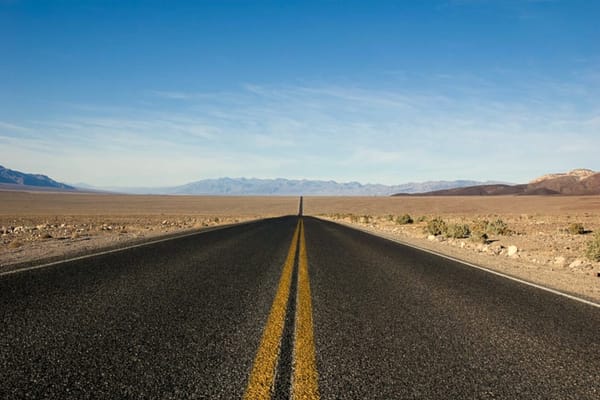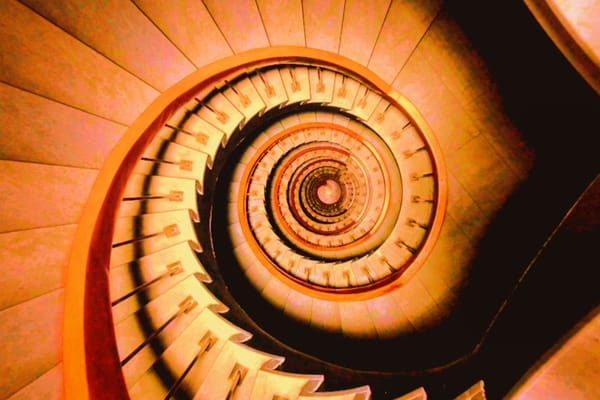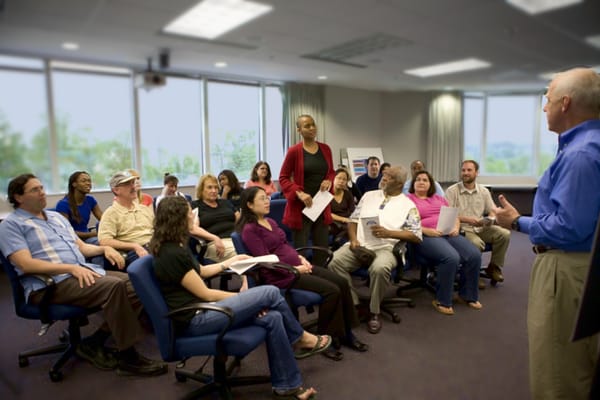Me against the World

We all want to change the world, but social change doesn’t come from converting every person, one by one. The current crop of new urbanists and champions of active mobility don’t aim to bully each listener into a new lifestyle. We won’t expect you to defy the incentives that make driving sensible for you. We only ask to have the option to safely walk, ride, and roll. This demands new considerations in the built environment, not in your individual choices.
Transcript
The Yellow Light: “Me against the World.”
We all want to change the world, but social change doesn’t come from converting every person one by one. The current crop of new urbanists and champions of active mobility don’t aim to bully each listener into a new lifestyle.
We won’t expect you to defy the incentives that make driving sensible for you. We only ask to have the option to safely walk, ride, and roll. This demands new considerations in the built environment, not in your individual choices.
If I were to sum up what I’m going to talk about, it’s basically this. Individual choice versus social change. The movement to make stronger towns, to have new urbanism—what-have-you.
It’s about what is around us and how that shapes people’s decisions. It’s not about the decisions of individuals as a response to that environment. Expecting better drivers, perfect drivers, perfect people, that’s exactly what we need to get away from.
I want to see fewer people needing to drive, hopefully choosing not to drive where possible, but not needing to drive as much because the fewer times you drive, the fewer times you’re putting yourself and others at risk, the less damage you’re doing to the environment around you, the less you’re imposing on others, on their space. All of the above. It’s like cigarettes.
I don’t want a healthier cigarette to avoid lung cancer. If I don’t want lung cancer, I should just not smoke as much. Not everybody’s going to quit instantly one hundred percent, but maybe instead of a pack a day, you’re only smoking one or two cigarettes a day.
Driving’s similar. We’re not trying to make everybody go outside and burn a car. If you have a car, go outside and burn it, take it apart.
No, that’s not the point. Cars—private cars—do serve a purpose. Should they serve every purpose? No.
Is a Phillips head screwdriver good? Yes. Should you use a Phillips head screwdriver for everything? You turn it around and bang it on nails with the handle side? No. Should you use a Phillips head screwdriver to repair clothing, to fix a faucet? Probably not. But that doesn’t mean we should get rid of the Phillips head screwdriver entirely.
For those who can do it, for those for whom it may be a slight inconvenience but not impossible, I would like to see those people drive less. Maybe if it’s a short trip and it’s feasible, maybe walk or ride a bike, roll—whatever it is.
You don’t need to drive for everything. Maybe you could drive for fewer things. If you expect to have free parking and the environment around us often encourages us to expect free parking and congestion-free roadways everywhere, it might make sense.
It may feel natural to drive everywhere. And if you can do that less, that would be great. You probably can.
But we’re not going to change everything by that. I don’t want to go door to door trying to convert everyone. If I were to compare this to movements to make America less racist, less discriminatory, Martin Luther King Jr. had his eyes on the prize.
He led the Million Man March in Washington, DC. Some of the greatest changes came through the Civil Rights Act and the Voting Rights Act. This made it illegal to have discrimination at restaurants, water fountains, to have... It also meant for the first time in a very long time, blacks could vote in the South again. After Reconstruction ended with the Compromise of 1877, very bad elements took power in society again and effectively disenfranchised most black people in America.
Martin Luther King Jr., however, did not only look at that. He did not dismiss people as irredeemable. At the same time, he didn’t want to redeem everybody and take his time with every individual person.
You convert certain people in places of power, and you try to have wide, effective changes where possible. One person who’s fairly famous in anti-racism efforts in recent times is Darrell Davis. He has befriended several members of the Ku Klux Klan, becomes friends with these people, and these people, they stop being white supremacists.
They’re friends with Darrell Davis, who’s a black guy, and he’s alright. He’s good. I like him.
Wait. Why am I racist? I think that’s great, and it’s certainly a lot better and a lot more than 99% of everybody is doing on this front. It’s great.
I also don’t harbor delusions that this is going to change America. Not unless you have many, many people doing this all the time. You’re going to need structural or social or political changes.
That’s what the movement to change the built environment is about. It’s not trying to make every individual person make perfect choices. It’s trying to change the system that encourages certain behaviors or makes certain behaviors impossible.
A lot of people under this umbrella in North America tend to have a more liberal attitude towards crime and a more tolerant attitude in general. They’re not going to be law and order. They’re not like that.
Unfortunately, this means that people who have some privileges, say, being male, tall, young, able-bodied, etc., people who can defend themselves in the case of violent crime, they tend to dismiss the concerns of others and tell people to get over it. That’s not going to change the fact that transit in North America is more dangerous than it is in other countries. It’s not because transit in and of itself is dangerous.
No, no, no. It’s far safer for society. In terms of lives, major injuries, certainly, certainly much better.
The problem is people. We have a lot of crime in North America, especially in the USA. There is a lot of crime.
That’s undeniable. It’s a lot less safe in, say, a subway system in LA than it is in Seoul, Korea. But South Korea does not have a totalitarian police state.
That’s not because the people there are so good or so bad. It’s because when you have transit that everybody rides, most people everywhere, most people are good. And the most, quote, “normal people” you have, the better.
If the only people who ride transit are those who are desperate to ride transit and those who cannot move in any other way, then you’re going to have a lot of good people who can do other options, pursue those other options. I wouldn’t advocate that level of individualized security where if you’re a single mother, you have kids and you need to protect yourself, you need to drive a car. And that may be what’s feasible right now for where you live.
And then expect everybody else to do the same. That’s going to leave out many people who will have to take transit, will have to take buses, et cetera. And even if everybody could get her own SUV to protect the kids, the family themselves, that’s still going to be much less safe than if all those people were riding transit and trains and buses.
We shouldn’t expect any person to be the first one to completely put themselves at risk. That’s not going to change things. If you’re the one person who’s doing that, thank you.
But you are putting yourself at risk. We don’t see people take those risks and that’s to be expected. A lot of infrastructure makes it so that if you want to, say, ride a bike to commute, you have to go on the roadway.
This means that most of the people you see on bikes will be able-bodied men, fifteen to fifty. Even an old person on an e-bike—even if that e-bike is fast—is not going to take the lane on a stroad where cars are going 45 miles per hour. You’re not going to see a ten-year-old girl on rollerblades in the middle of downtown, in the middle of the roadway.
It’s not going to happen. I don’t want people to put themselves at risk and do daredevil things, but these acts aren’t daredevil-ish. Rollerblading is not the most dangerous thing you can do.
What makes it dangerous to do in public is that you have cars. If riding on roller skates is not safe, if XYZ is not safe for your twelve-year-old kid to do unsupervised, then doing X, Y, Z isn’t safe. Right now, doing XYZ may not be safe.
I want to make it safe. I want to see it as safe. What I expect from other people is not to stand in the way of things that would make it safe.
If people have to drive, also please be considerate. I’ve seen it way too many times where people get accustomed to thinking a certain way, and it’s not because these individuals are so different, us and them. It’s the lifestyle.
I know it feels good to talk about car brains, whatever, but nobody’s irredeemable. I used to think a certain way because I had driven and it was the only feasible option, and it’s all I ever knew. It’s all my peers had ever known.
It makes you think a certain way. It makes you do things that are really quite illogical. You may be the person who passes me.
When I’m riding my bike, if there’s no bike lane—if there were, I would take it, but if there’s none on the path I’m going to the place I’m going, I’m going to have to be in the roadway. Sometimes you might be that person who has to go around me.
You go around, swerve back, and then slam on the brakes because there’s a red light fifty feet ahead. It was not necessary to pass me like that, but it’s almost ingrained to do things like that and you start seeing things in a different way. It’s not because you are a bad person.
It’s not any of that. Any human in a certain situation will behave a certain way because of the environment around you. I think that’s a very important thing to remember.
We should be looking at how the system shapes behavior. When it comes to, say, international relations, there are two extremes, you could say. Those who just see it as foreign policy, the aggregation of foreign policy in many countries, and those who see it as completely structural, that the dynamics of the world condition everybody.
Everybody’s going to act the same regardless of what their citizenry, their history, perceptions are like. I think the truth is in the middle, but if I had to choose a side, I would go with the structural side. A theorist within international relations is Kenneth Waltz.
He argued that what he studied was not foreign policy, it was international politics. It was a different beast. Within structural realism, you had some people who disagreed about the best way to protect yourself, but the fundamental thing was that war was going to be possible and likely when you have an environment where there’s no one to turn to, it’s self-help.
You are completely on your own. That’s what every country is in the world. It is really on its own.
There is no guarantee that your allies will help you, that a world police will help you. You’re on your own. So your country, no matter what, your country is always going to think about its own survival.
That is going to shape a lot of behavior. You’ll still have diversity of behavior within those parameters. I think that’s very important, but certain actions are going to be more likely.
Certain actions, events are going to be possible, some impossible. You can analogize too with sports, say with American football, which by the way, is called that because it’s played on foot, not on a horseback, not because foot doesn’t kick. American football, you could have the quarterback choose to pass the ball, to run it, but the quarterback cannot walk out of bounds, run out of bounds, get up after being tackled with association football or soccer.
You can kick the ball, you can do many things. You can trap it with your foot, you can catch a free throw with your chest, have it go down before you and dribble it, move it, pass it, shoot it. But if you’re not the goalkeeper, you cannot pick up the ball with your hands.
There are certain parameters. What you can do is limited by the rules of the game. The built environment is very similar to that.
What we can do, what we cannot do is fixed by the game itself. To make another analogy with political studies, social movements. Some of the earlier literature on that from the 1950s saw the civil rights movement in its infancy as something of a pathology, something that individuals did when they had nothing better to do.
They were looking at things very individualistically. They did not conceive of a group dynamic or society as a whole changing in the same way. They saw these issues always with racism as individual pathologies.
I would say that’s an outdated, wrong, and itself, yeah, it does border on itself racism and in many cases goes explicitly racist. Culture can be a good way of understanding why people do what they do. But culture does not exist in a vacuum.
It’s the result of our environment. Our environment itself too is part of our culture. Our environment too is decided by the culture.
It’s a circular relationship, but we always have to mind that structure and not make it completely about ideas and culture because then it’s a slippery slope to thinking about the ideas in one’s head. And then we get to talking about individuals. Even allies within these conversations about urbanism, town planning, they may say, “Oh, I agree with you. We should have more bicycle riding. It should be safe. This should be the case. But that’s a big ask of people,” or they say people should be different. “I’m frustrated!” And maybe that person does not ever drive and wants everybody else to make the same virtuous decision. That’s not really going to change everything.
We still need people like that, but they alone cannot change the whole of society. And changing everybody to become a bike rider might build a constituency for the new bike lane, but that’s not going to make the bike lane happen. You’re going to have to turn those beliefs into group action to agitate for the things you want.
And it’s not just want, it’s also need. If we’re going to have a different way of doing things, which we might have to regardless of what we want, because the finances of the post–World War II suburban sprawl experiment, those costs are not sustainable. Environmental problems, cost of oil and on and on.
We’re going to have to see a different way of doing things. So this is about need. We need it to be safe to do certain things.
We need it to be sensible to do certain things. If we want people’s behaviors to change, we have to change the incentives. We cannot ignore reality.
A good thing to remember when you assess if doing XYZ is safe or not is to ask if you would let your 12-year-old kid do that unsupervised. If you do not feel comfortable with that, then that activity is not safe. But then you have to ask, why is that activity unsafe? Is walking, is riding a bike really that dangerous compared to driving? No.
For drivers in cars and for people on the roadway too. They cause forty thousand deaths per year in America and many, many more serious injuries. Remember, you could lose an arm and a leg literally and still live.
Deaths alone does not come close to capturing the amount of damage to human lives. And if you want to get into it, property damage. I don’t want to have a society where a car could go crashing into a pharmacy at any moment.
That’s not a rational way to set up your society, to have that be a thing that happens. It’s not a fact of life. It does not happen regularly in Europe and Asia.
It’s a very American thing. That’s not about the individuals being bad. If that person is in his nineties and shouldn’t be driving, well, okay, how else is this person going to get to the pharmacy? You’ve built an environment where the only way for this ninety-year-old man to reach the pharmacy to get the drugs he needs, his heart medication, or say his wife’s ankle brace is to drive twenty miles.
Well, of course, this is going to happen. You don’t stop it by turning everybody into a homebody. You don’t stop it by expecting everyone to be a perfect driver.
What you’re going to send that ninety-year-old to driving school again? With all these decisions, we have to remember that we can’t just say, “Oh, well, it’s your freedom to do this or that.” Your freedom to drive wherever you want in a one-and-a-half, two-ton or three-ton vehicle is only possible because everybody else is paying for it. The government is building all these highways, this free parking and saying, “Hey, look. This is for you.”
Of course, people are going to choose to do that, but their choice to get the biggest car possible affects others. It takes space from others, it blocks the sidewalks where people who use wheelchairs need the space. Oh, just go around.
Oh, just go in the grass. No, if you’re in a motorized wheelchair, that’s not an option at all. The point is that all these decisions interact and they affect other people and nobody is making decisions completely alone.
If somebody is buying a too-big truck, it’s because of advertising, because of peer groups, because of incentives, because of lanes that are twelve feet wide on the roadways instead of eight feet wide. A good way to remember all of this is that no one is an island.
Opening theme music by Computer Music All-Stars, “May the Chords Be With You,” released 2018, available on the Free Music Archive. Closing theme from the Korea Copyright Commission, a 2022 performance of Samul-nori music, available at Gongyu Madang, LSMBG 0704. Logo art by Kyle Keswick of Keswick Design Company in Plattsburgh, New York, with edits for contrast and color. Recorded in Plattsburgh, New York, copyright 2025 by Sae Ong Jee Ma LLC.
Credits
Opening theme music by Computer Music All-Stars, “May the Chords Be with You,” released 2018, available on the Free Music Archive, licensed CC BY 4.0. Closing theme from the Korea Copyright Commission, a 2022 performance of samul-nori music, available at Gongyu Madang, LSMBG0704, licensed CC BY-SA 2.0 KR. Logo art by Kyle Keswick of Keswick Design Company in Plattsburgh, New York, with edits for contrast and color. Recorded in Plattsburgh, New York. Copyright 2025 by Sae Ong Jee Ma LLC.





